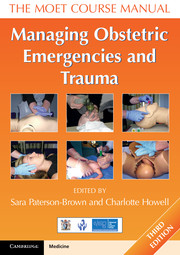Book contents
- Frontmatter
- Dedication
- Contents
- Working Group
- About the authors
- Acknowledgements
- Abbreviations
- Section 1 Introduction
- Section 2 Recognition
- Section 3 Resuscitation
- Section 4 Trauma
- Section 5 Other medical and surgical emergencies
- Section 6 Obstetric emergencies
- 24 Pre-eclampsia and eclampsia
- 25 Major obstetric haemorrhage
- 26 Caesarean section
- 27 Placenta accreta and retained placenta
- 28 Uterine inversion
- 29 Ruptured uterus
- 30 Ventouse and forceps delivery
- 31 Shoulder dystocia
- 32 Umbilical cord prolapse
- 33 Face presentation
- 34 Breech delivery and external cephalic version
- 35 Twin pregnancy
- 36 Complex perineal and anal sphincter trauma
- 37 Symphysiotomy and destructive procedures
- 38 Anaesthetic complications in obstetrics
- Section 7 Triage and transfer
- Section 8 Human issues
- Index
26 - Caesarean section
- Frontmatter
- Dedication
- Contents
- Working Group
- About the authors
- Acknowledgements
- Abbreviations
- Section 1 Introduction
- Section 2 Recognition
- Section 3 Resuscitation
- Section 4 Trauma
- Section 5 Other medical and surgical emergencies
- Section 6 Obstetric emergencies
- 24 Pre-eclampsia and eclampsia
- 25 Major obstetric haemorrhage
- 26 Caesarean section
- 27 Placenta accreta and retained placenta
- 28 Uterine inversion
- 29 Ruptured uterus
- 30 Ventouse and forceps delivery
- 31 Shoulder dystocia
- 32 Umbilical cord prolapse
- 33 Face presentation
- 34 Breech delivery and external cephalic version
- 35 Twin pregnancy
- 36 Complex perineal and anal sphincter trauma
- 37 Symphysiotomy and destructive procedures
- 38 Anaesthetic complications in obstetrics
- Section 7 Triage and transfer
- Section 8 Human issues
- Index
Summary
Objectives
On successfully completing this topic, you will be able to:
understand how to anticipate and, to some extent, avoid difficulties encountered at CS
appreciate the techniques that can help you cope with such difficulties.
Introduction
CS is the process of delivering a baby abdominally. It may be required on fetal grounds or on maternal grounds. Rates vary enormously, not only between countries but also between hospitals, but trends are generally increasing worldwide. In the UK, the CS rate for 2011–12 was 25%, according to the NHS maternity statistics report. This reflects the fact that, in most developed countries, around one in four women will deliver by CS. The caesarean rate continues to rise in developing countries as well, and has now reached 50% in China. CS has become one of the most (if not the most) commonly performed operations in the world.
The decision to perform a CS can be obvious in some circumstances, while in others it can be extremely difficult. This decision-making skill in terms of timing and mode of delivery is acquired over many years, with experience and clinical judgement. CS should never be seen as the easy option. All risks of CS, as opposed to those of proceeding with an attempt at labour and vaginal delivery, should be considered and balanced in each individual circumstance, taking into account both maternal and fetal interests.
This chapter is not designed to list the indications or arguments for CS, nor to give intricate detail into surgical technique, but rather to highlight the difficulties that can be encountered (both anticipated and unexpected) and to suggest ways in which they can be predicted, recognised and dealt with in the acute situation.
- Type
- Chapter
- Information
- Managing Obstetric Emergencies and TraumaThe MOET Course Manual, pp. 313 - 324Publisher: Cambridge University PressPrint publication year: 2014

